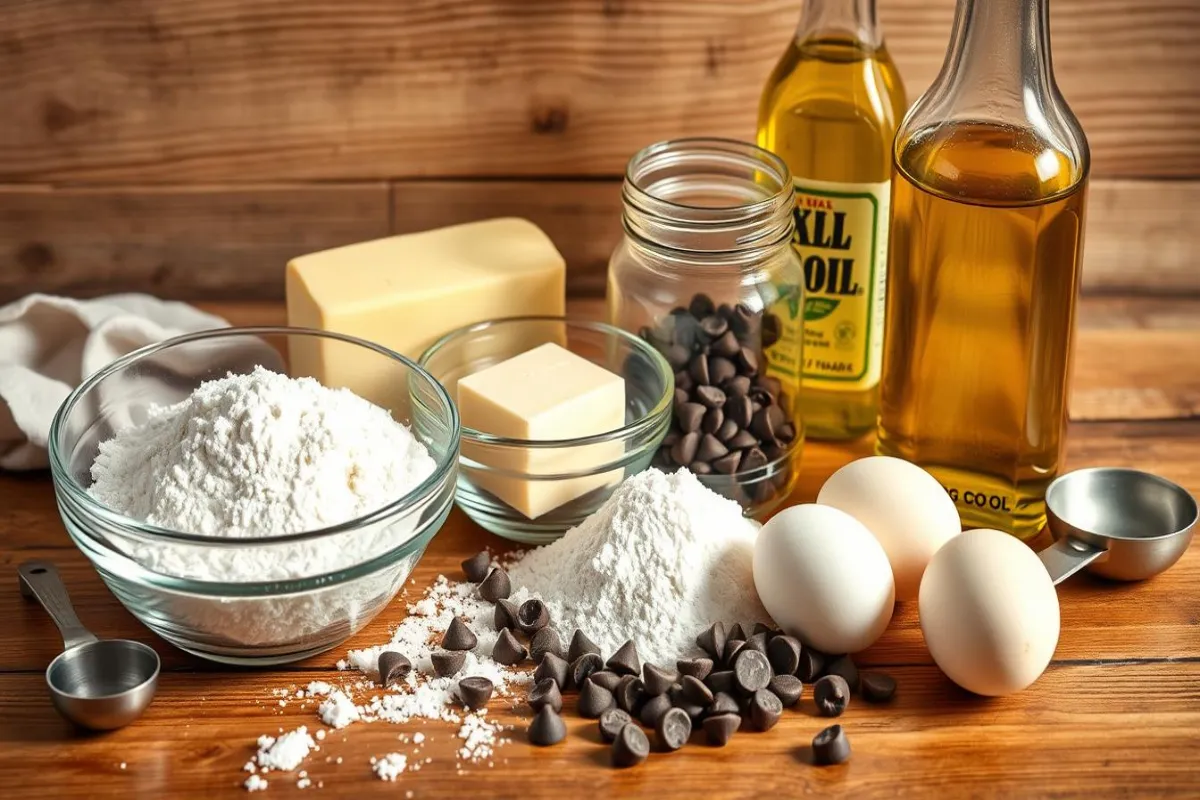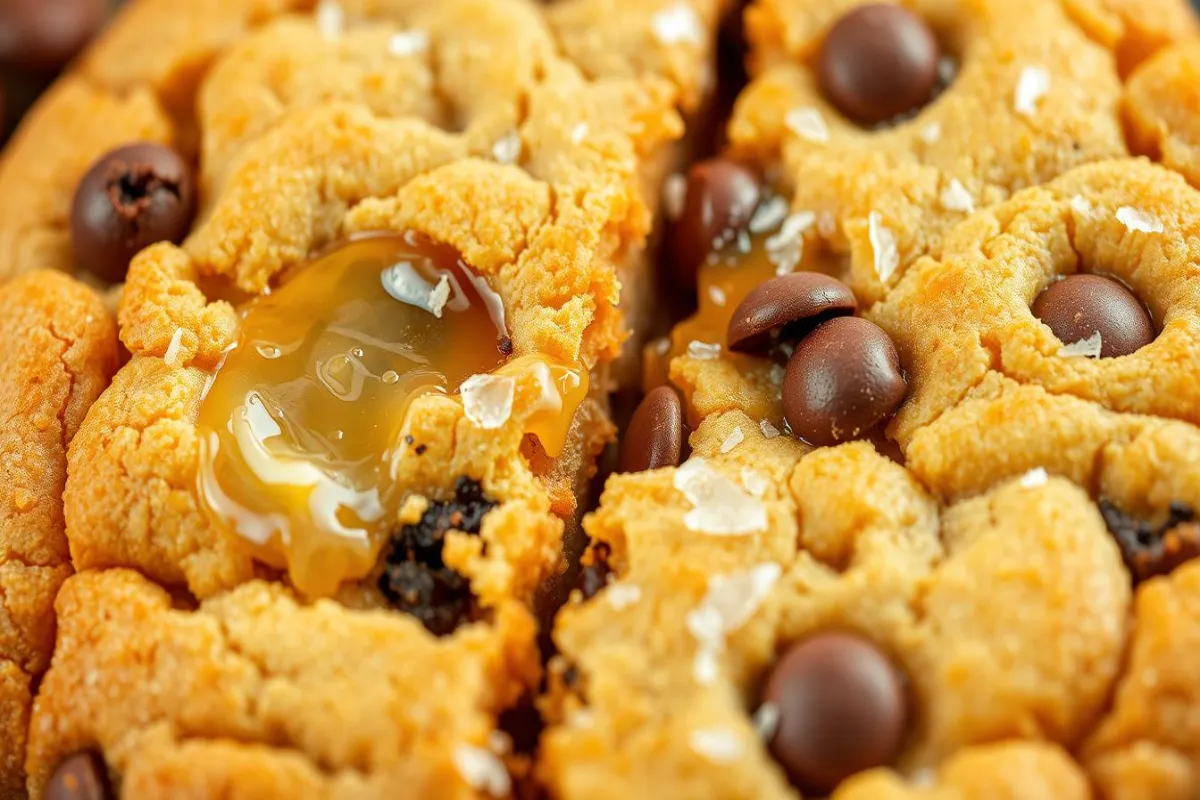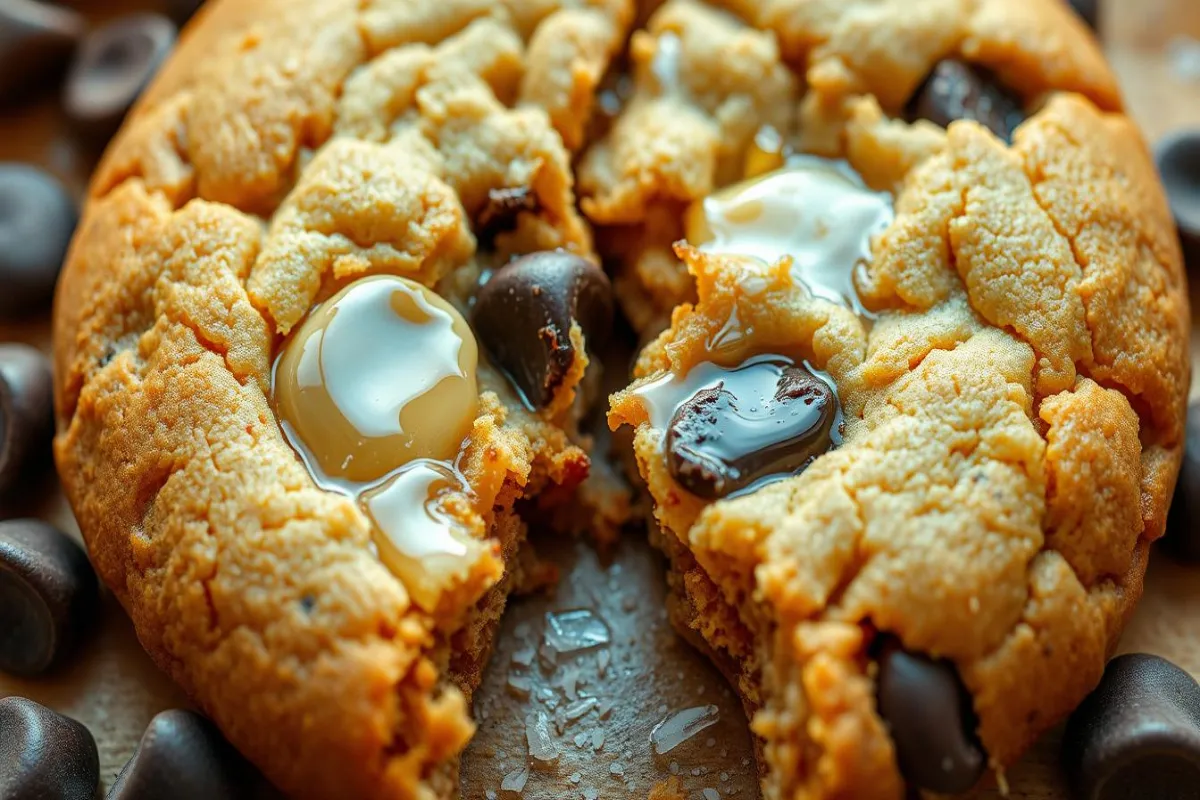Choosing between butter and oil can greatly affect your cookies. Whether you’re using a cake mix or making them from scratch, knowing the differences is key. We’ll look at how butter and oil change cookie texture and taste. Plus, we’ll share tips and recipes to help you get the best results for your cake mix cookies.
Baking Ingredients: Butter vs. Oil
Choosing between butter and oil in baking can change your cookie’s taste and look. These fats, key in baking ingredients, affect the texture, flavor, and appearance of your treats.
Exploring the Differences
Butter, made from milk, adds a rich taste to cookies. Oil, from plants, has a milder flavor. Their different forms and tastes affect how your cookies turn out.
The Roles of Fats in Baking
Fats are crucial in baking, adding structure, tenderness, and feel to cookies. Butter and oil’s unique qualities lead to different textures and looks in your baked goods.
| Characteristic | Butter | Oil |
|---|---|---|
| Composition | Solid fat derived from milk | Liquid fat typically extracted from plants |
| Flavor | Rich and creamy | More neutral |
| Melting Point | Lower, melts at room temperature | Higher, remains liquid at room temperature |
| Texture Impact | Contributes to a tender, flaky texture | Produces a crisper, more uniform texture |
Knowing how butter and oil work in baking ingredients is key. It helps you understand their effect on baked goods.

Cookie Texture: How Butter and Oil Affect It
Choosing between butter and oil in cake mix cookies changes the texture a lot. Butter makes cookies crisper and chewier. Oil makes them softer and more like cake.
Crispiness and Chewiness
Butter has more saturated fat than oil, making cookies crisper. It also makes the center chewier. Oil, on the other hand, makes cookies tender and cake-like.
Spread and Rise
Butter and oil also affect how cookies spread and rise. Butter keeps dough tight, making cookies puffier. Oil lets dough spread more, making cookies flatter.
| Cookie Trait | Butter | Oil |
|---|---|---|
| Crispiness | Higher | Lower |
| Chewiness | Higher | Lower |
| Spread | Less | More |
| Rise | Higher | Lower |
Knowing how butter and oil change cookie texture is key. It helps when trying new cookie recipes and baking tips. It’s especially useful with cake mix hacks. Changing the fat can make your cookies just right, whether you like them crispy or soft.

Choosing between butter and oil in cake mix cookies can change the taste and texture. Both fats are important for making great cookies. But, they can make the cookies taste and feel different.
Butter adds a creamy taste that makes cookies feel rich. It makes the cookies tender and golden. Oil, with its mild taste, makes cookies soft and chewy with a lighter texture.
Whether to use butter or oil depends on what you like. If you want a richer cookie, butter is good. For a softer cookie, oil is better. Try both to find your favorite.
Butter vs. Oil: Exploring the Differences
n baking, butter and oil play different roles. While butter helps cookies retain their shape and adds a crisp texture, oil contributes to a softer dough that spreads easily, resulting in chewy cookies.
| Butter | Oil |
|---|---|
| Richer, more indulgent flavor | Neutral, more versatile taste |
| Helps create a crisp, golden-brown exterior | Produces a softer, chewier cookie |
| Contributes to a tender, melt-in-your-mouth texture | Leads to a more uniform, pliable cookie dough |
Using butter or oil in cake mix cookies can both make delicious cookies. It’s about knowing how they work with other ingredients. Choose based on what you like and what you want your cookies to be like.
Flavor Profiles: Butter or Oil?
Choosing between butter and oil can change how your cake mix cookies taste. Butter gives a richer, creamier flavor. Oil, on the other hand, lets other tastes shine.
The Richness of Butter
Butter is famous for adding a butter-y taste to baked goods. Its high fat content makes cookies taste decadent and indulgent. The creaminess of butter also makes cookies feel satisfying and comforting to eat.
The Neutrality of Oil
Vegetable or canola oil has a neutral taste. This lets vanilla, chocolate, or nuts flavors stand out. It’s great for making a versatile cookie that can be customized with different baking ingredients and flavor profiles.
| Butter | Oil |
|---|---|
| Rich, creamy flavor | Neutral, versatile flavor |
| Enhances mouthfeel and indulgence | Allows other flavors to take center stage |
| Ideal for classic, buttery cookies | Suitable for a wider range of cookie flavors |
“The richness of butter can elevate your cookies to new heights of decadence, while the neutrality of oil provides a versatile canvas for a variety of flavors.”
Cake Mix Hacks: Enhancing Flavor and Texture
Baking with cake mixes is quick and easy. But, you don’t have to stick to basic cookies. With a few tricks, you can make your cake mix cookies special and tasty.
Adding extra ingredients can make your cookies unique. Try adding vanilla extract or cinnamon for extra flavor. For a rich taste, melt chocolate and mix it into the dough before baking.
- Experiment with spices like nutmeg, ginger, or cardamom to create warm, cozy flavors.
- Fold in chopped nuts, dried fruit, or chocolate chips for added texture and crunch.
- Substitute milk or buttermilk for the water called for in the cake mix instructions to create a richer, more tender cookie.
Be creative with your cookie shapes and sizes. Make them bigger for a chewy cookie or thinner for a crisp cookie bar.
| Cake Mix Hack | Effect on Texture |
|---|---|
| Adding extra vanilla or spices | Enhances flavor and aroma |
| Incorporating mix-ins like nuts or chocolate | Adds crunch and contrasting textures |
| Substituting milk or buttermilk for water | Results in a more tender, moist cookie |
| Adjusting cookie size and shape | Influences crispness, chewiness, and spread |
Try these cake mix hacks to make your cookie recipes stand out. They’ll impress everyone. Get creative and have fun with different flavors and baking methods.
Baking Tips: Getting the Perfect Cookie
To get the perfect cookie, you need to control the temperature, mix carefully, and solve common problems. These tips will help you make your cookie recipes better and get a great cookie texture every time.
Temperature and Mixing Techniques
Temperature is key for baking tips. Make sure your oven is at the right temperature. Use an oven thermometer to check it’s correct. Also, let your butter or oil warm up to room temperature before mixing. This helps your cookies turn out better.
Choose the right tools and techniques for mixing. Fold dry ingredients gently to avoid tough cookies. Don’t mix too fast, as it can make the cookies dense and less tasty.
Troubleshooting Common Issues
- Spreading: If cookies spread too much, chill the dough or add more flour.
- Dryness: Avoid dry cookies by not overbaking and using the right mix of wet and dry ingredients.
- Uneven Baking: Rotate baking sheets halfway through to bake evenly and get a consistent cookie texture.
Follow these baking tips to make perfect cookies. You can use butter for rich flavor or oil for versatility in your cookie recipes.
Fat Content in Baking: Finding the Right Balance
In baking, the fat content greatly affects the health and taste of your treats. Knowing how fats work and balancing butter and oil is key. This way, you can enjoy tasty baked goods that are also good for you.
Butter is a favorite in baking for its creamy texture and flavor. Yet, it has more fat content in baking and saturated fat than oils. Oils like olive, canola, or coconut oil are healthier, with less baking ingredients and saturated fat.
The choice of baked goods ingredients changes your cookies’ texture and taste. Butter makes them tender and crumbly, while oils make them chewier and cakier. Try different fat mixes to get the texture you want.
| Fat Type | Saturated Fat (per tbsp) | Total Fat (per tbsp) | Calorie Content (per tbsp) |
|---|---|---|---|
| Butter | 7g | 11g | 102 calories |
| Olive Oil | 2g | 14g | 119 calories |
| Coconut Oil | 12g | 14g | 121 calories |
| Canola Oil | 1g | 14g | 124 calories |
Understanding fat content in baking and the roles of fats helps you balance indulgence and health. This way, you can bake your favorite treats while staying healthy.
Cookie Recipes: Experimenting with Butter and Oil
Baking cookies is an art that needs the right mix of ingredients. Choosing between butter and oil changes the cookie’s texture and taste. We’ve got two recipes for you – one with butter for a rich taste and another with oil for dietary needs.
Classic Butter Cookies
If you love the taste of butter in cookies, try this recipe. It uses creamy butter, sugar, and vanilla for a soft, delicious cookie. These are great for celebrations or just enjoying with a drink.
- Cream together 1 cup of unsalted butter and 1 cup of granulated sugar until light and fluffy.
- Beat in 1 egg and 2 teaspoons of vanilla extract.
- In a separate bowl, whisk together 2 1/4 cups of all-purpose flour, 1/2 teaspoon of baking powder, and 1/4 teaspoon of salt.
- Gradually mix the dry ingredients into the wet ingredients until a dough forms.
- Chill the dough for at least 30 minutes, then scoop and bake at 350°F (177°C) for 10-12 minutes.
Oil-Based Cookies for Dietary Restrictions
For those who can’t have butter, like vegans, this oil-based cookie is a tasty option. Using vegetable or coconut oil keeps the cookie’s texture and taste without dairy.
- Whisk together 2 cups of all-purpose flour, 1 teaspoon of baking powder, and 1/4 teaspoon of salt.
- In a separate bowl, combine 1 cup of granulated sugar, 1/2 cup of vegetable or coconut oil, 1/4 cup of unsweetened almond milk, and 2 teaspoons of vanilla extract.
- Gradually mix the dry ingredients into the wet ingredients until a dough forms.
- Scoop the dough onto a baking sheet and bake at 375°F (191°C) for 12-15 minutes.
Whether you love buttery cookies or need something dairy-free, these recipes are a fun way to try butter versus oil. Experiment to find the perfect cookie for you.
Baked Goods Ingredients: The Science Behind the Scene
Baking is a mix of art and science. Ingredients like fats are key to success. Knowing how butter and oil work can help you bake better.
Fats like butter and oil do more than add flavor. They are crucial for baking. Butter makes baked goods rich, tender, and flavorful. Oils add moisture and a soft texture without changing the taste much.
The magic happens because of how these fats interact with other ingredients. Butter melts and creates steam, making baked goods flaky. Oils, being liquid, help create a dense, even texture.
| Ingredient | Functionality in Baking | Advantages |
|---|---|---|
| Butter | Provides richness, tenderness, and distinct flavor | Flaky, tender texture |
| Oil | Contributes moisture and a more uniform, dense structure | Neutral flavor, suitable for dietary restrictions |
Knowing the science behind baking can help you make better choices. This leads to perfect baked goods every time.
“The key to successful baking lies in mastering the interplay of various ingredients and understanding their unique properties.”
Conclusion
Choosing between butter or oil in cake mix cookies comes down to what you like best. Both fats have their own benefits and can make your cookies delicious and full of texture. Try different recipes and techniques to find the perfect mix for your baking.
Whether you love the creamy taste of butter or the neutral taste of oil, it’s all about knowing how they affect your cookies. By learning how to use is it better to use butter or oil in cake mix cookies? well, you can make cookie recipes that look great and taste amazing.
Don’t forget, baking tips and cake mix hacks are key to making perfect cookies. By tweaking your methods and temperatures, you can solve common problems and get perfect results every time. Baking is all about trying new things and showing off your creativity in your is it better to use butter or oil in cake mix cookies?.
FAQ
Butter comes from milk and is solid. Oil comes from plants and is liquid. These differences change how they bake. Butter makes cookies taste richer and chewier. Oil makes them softer and more like cake.
The fat you choose changes the cookie’s texture. Butter makes cookies crispy and chewy. Oil makes them soft and cake-like. The fat also affects how the cookies spread and rise.
Butter adds a creamy taste. Oil lets other flavors stand out. Choose based on your taste preferences and recipe.
Yes, you can try different hacks. Add vanilla, spices, or melted chocolate. These can make your cookies unique and tasty.
Fat content affects cookie health. Knowing about fats helps balance butter and oil. This way, you can enjoy treats that are still somewhat healthy.
We have recipes for classic butter cookies and oil-based ones for special diets. Try different recipes to find your favorite mix of butter and oil.

